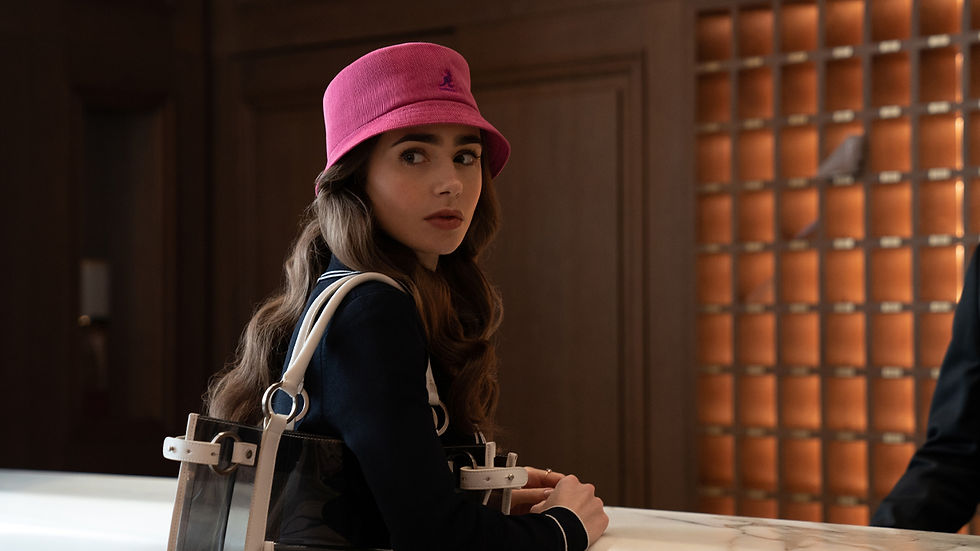There’s Something Amiss in Emily In Paris - And It’s Not The Fact That She’s White
- Sadia Parveen
- Nov 9, 2020
- 4 min read
Updated: Nov 29, 2020
Emily In Paris has been one of the most popular choices on Netflix in the recent past, not least because of the appeal of Lily Collins traipsing across the world’s most romantic city. The titular character, Emily Cooper makes a transatlantic move from Chicago to Paris to replace her pregnant boss to bring an American perspective as a media marketing strategist to an established French marketing firm, Savoir. Watching a twenty-something-year-old white woman making the big move to Paris without knowing a lick of the French language and having French men falling for her wide-eyed American charm, while she blogs her new Parisian life on an Instagram account honestly, sounds like a much-needed vacation at a time when reality feels so limiting. But the show has received many polarizing opinions, with quite a bit of criticism pointing to issues such as the lack of diversity, the continued harnessing of the age-old narrative of seeing Paris through a white, thin and able-bodied girl’s eyes, coupled with harsh reactions from the French audience who called it an embarrassing, hyper-sexualized and cliche portrayal of Paris.

Created by Darren Star, who is known for creating cult classics like Sex and the City and Younger, Emily in Paris has apparent similarities in their presentation. Never having watched a single episode of Sex and the City, I could understand the appeal of it, as Emily in Paris felt like a reincarnation, staged and set in the beautiful backdrop of Paris. I am one of the people who binged Emily in Paris as soon as it premiered and took the show for what it was, an effortless no-brainer binge watch. Throughout the episodes, I was made aware of the fact that Emily was able to have these chic experiences because of her privileges, and if she were to be a woman of color, the tone of the show would differ in spades.
There is something to be said about pushing for diversity or the lack thereof in an experience that was never written with antipodal identities in mind. The questions asked around this topic shouldn’t be “Why Emily couldn’t have been a woman of color?” but “When will writers and creatives write stories that are tailored for us and that make sense to our narratives and experiences?” Discussions about diversity and inclusivity shouldn’t be about campaigning to make Emily a woman of color and exhibit the same experiences a white woman would have. A Black/Brown lead starring Emily in Paris would also have to deal with the harder to digest, but real issues like the racial struggles and microaggressions faced in a France that likes to call itself constitutionally ‘color-blind’ and devoid of ‘identity politics’ - which furthers the erasure of our identities like race and religion. As a Brown woman, I am exhausted with these portrayals of women of color that were clearly written with a white female in mind. Performative diversity and inclusivity use our ethnicities as a marketing strategy, yet leave our race at the door, and that’s why it’s okay for Emily, in Emily in Paris to be white and for the show’s perspective to be through her experiences. Where Emily in Paris fails to deliver is a well written, diverse representation of the supporting characters in the series.

Emily in Paris has two persons of colour as recurring characters, Mindy Chen (played by Ashley Park) who is Emily’s first friend in Paris. A Chinese-Korean, Mindy lives in Paris and works as a nanny to support herself after her wealthy zipper manufacturing father cuts her off for not going back to Shanghai to take reigns of their business, which is something that Mindy doesn’t want. What ensues are various dialogues and scenes where we see China through an American perspective, which to put it kindly, is flawed and shunned in a negative light. Then there’s Julien (Samuel Arnold) - he’s Black, dresses fashionably and works with Emily at Savoir and eventually becomes her friend - that’s pretty much his entire role in this 10-hour long Netflix series. The Persons of Color existing in stories only to be a helping/guiding hand for the main white characters trope is so incredibly lazy and lacklustre in 2020, and in some ways feels like the writer’s room was stuck in their Sex and the City years. We could have seen a perspective of a Black Parisian working in a well-established firm like Savoir and his experiences with bigotry and racism, but Emily in Paris fails here, which makes it apparent that it was created in keeping with a white target audience in mind. It’s okay for Emily to be a white woman, but the lack of diversity in a series that had so much potential leaves a lot to be desired.
So if you’re looking for a mindless rom-com to binge-watch on Netflix while being aware of its many shortcomings, then Emily in Paris is for you. As far as Season 2 is concerned, let us hope the creators take into account that it’s 2020 and make more of a conscious effort for more representation and less tokenism.






Comments